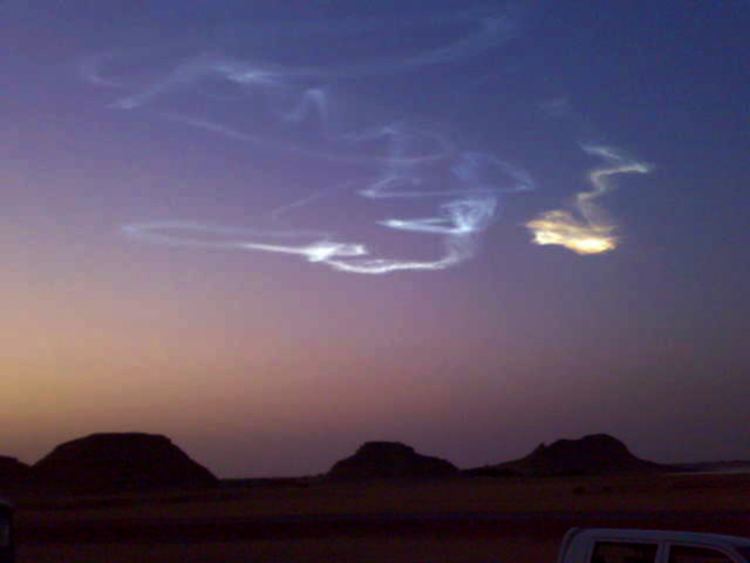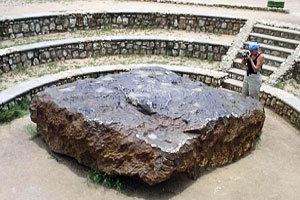Discovered 6 October 2008 Argument of perihelion 234.44897° | MPC designation 2008 TC3 Inclination 2.5422° Mean anomaly 330.7541° | |
Discovery date October 6, 2008, 06:39 UTC Minor planet category Near-Earth object (NEO), Apollo asteroid Aphelion 1.71644 AU (256.776 Gm) Semi-major axis 1.308201 AU (195.7041 Gm) Similar Solar System, 2014 AA, 1972 Great Daylight Fireball, 2009 DD45, 2011 MD | ||
Celestial meteorites asteroid called 2008 tc3
2008 TC3 (Catalina Sky Survey temporary designation 8TA9D69) was an 80 metric tons (80 long tons; 90 short tons), 4.1 meters (13 ft) diameter asteroid that entered Earth's atmosphere on October 7, 2008. It exploded at an estimated 37 kilometers (23 mi) above the Nubian Desert in Sudan. Some 600 meteorites, weighing a total of 10.5 kilograms (23.1 lb), were recovered; many of these belonged to a rare type known as ureilites, which contain, among other minerals, nanodiamonds.
Contents
- Celestial meteorites asteroid called 2008 tc3
- 2008 tc3 small asteroid to light up sky over africa
- Discovery
- Entry
- Search
- Analysis
- Full circle
- References
It was the first time that an asteroid impact had been predicted prior to its entry into the atmosphere as a meteor.

2008 tc3 small asteroid to light up sky over africa
Discovery

The asteroid was discovered by Richard A. Kowalski at the Catalina Sky Survey (CSS) 1.5-meter telescope at Mount Lemmon, north of Tucson, Arizona, US, on October 6, 06:39 UTC, 19 hours before the impact.

It was notable as the first such body to be observed and tracked prior to reaching Earth. The process of detecting and tracking a near-Earth object, an effort sometimes referred to as Spaceguard, was put to the test. In total, 586 astrometric and almost as many photometric observations were performed by 27 amateur and professional observers in less than 19 hours and reported to the Minor Planet Center, which issued 25 Minor Planet Electronic Circulars with new orbit solutions in eleven hours as observations poured in. On October 7, 01:49 UTC, the asteroid entered the shadow of the Earth, which made further observations impossible.
Impact predictions were performed by University of Pisa's CLOMON 2 semi-automatic monitoring system as well as Jet Propulsion Laboratory's Sentry system. Spectral observations that were performed by astronomers at the 4.2-meter William Herschel Telescope at La Palma, Canary Islands are consistent with either a C-type or M-type asteroid.
Entry
The meteor entered Earth's atmosphere above northern Sudan at 02:46 UTC (05:46 local time) on October 7, 2008 with a velocity of 12.8 kilometers per second (29,000 mph) at an azimuth of 281 degrees and an altitude angle of 19 degrees to the local horizon. It exploded tens of kilometers above the ground with the energy of 0.9 to 2.1 kilotons of TNT over a remote area of the Nubian Desert, causing a large fireball or bolide.
The Times reported that the meteor's "light was so intense that it lit up the sky like a full moon and an airliner 1,400 km (870 mi) away reported seeing the bright flash." A webcam captured the flash lighting up El-Gouna beach 725 kilometres north of the explosion (see this webcam frame). A low-resolution image of the explosion was captured by the weather satellite Meteosat 8. The Meteosat images place the fireball at 21.00°N 32.15°E / 21.00; 32.15 (2008 TC3 fireball). Infrasound detector arrays in Kenya also detected a sound wave from the direction of the expected impact corresponding to energy of 1.1 to 2.1 kilotons of TNT. Asteroids of this size hit Earth about two or three times a year.
The trajectory showed intersection with Earth's surface at roughly 20.3°N 33.5°E / 20.3; 33.5 (2008 TC3 projected impact) though the object was expected to break up perhaps 100–200 kilometers (62–124 mi) west as it descended, somewhat east of the Nile River, and about 100 kilometers (62 mi) south of the Egypt–Sudan border.
According to U.S. government sources U.S. satellites detected the impact at 02:45:40 UT, with the initial detection at 20.9°N 31.4°E / 20.9; 31.4 (2008 TC3 initial detection) at 65.4 kilometers (40.6 mi; 35.3 nmi) altitude and final explosion at 20.8°N 32.2°E / 20.8; 32.2 (2008 TC3 final explosion) at 37 kilometers (23 mi; 20 nmi) altitude. These images have not been publicly released.
Search
A search of the impact zone that began on December 6, 2008, turned up 10.5 kilograms (23 lb) of rock in some 600 fragments. These meteorites are collectively named Almahata Sitta, which means "Station Six" in Arabic and is a train station between Wadi Halfa and Khartoum, Sudan. This search was led by Peter Jenniskens from the SETI Institute, California and Muawia Shaddad of the University of Khartoum in Sudan and carried out with the collaboration of students and staff of the University of Khartoum. The initial 15 meteorites were found in the first three days of the search. Numerous witnesses were interviewed, and the hunt was guided with a search grid and specific target area produced by NASA's Jet Propulsion Laboratory in Pasadena, California.
Analysis
Samples of the Almahata Sitta meteorite were sent for analysis to a consortium of researchers led by Jenniskens, the Almahata Sitta consortium, including NASA Ames in California, the Johnson Space Center in Houston, the Carnegie Institution of Washington, and Fordham University in New York City. The first sample measured was an anomalous ultra-fine-grained porous polymict ureilite achondrite, with large carbonaceous grains. Reflectance spectra of the meteorite, combined with the astronomical observations, identified asteroid 2008 TC3 as an F-type asteroid class. These fragile anomalous dark carbon-rich ureilites are now firmly linked to the group of F-class asteroids. Amino acids have been found on the meteorite.
Full circle
Richard Kowalski, who discovered the object, received a tiny fragment of Almahatta Sitta, a gift from friends and well-wishers on the Minor Planet Mailing List, which Kowalski founded in order to help connect professional and amateur astronomers.
